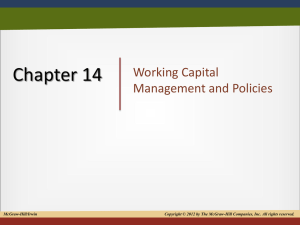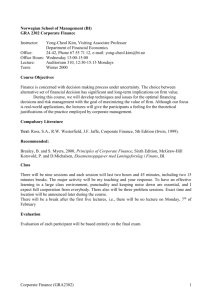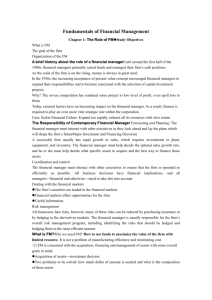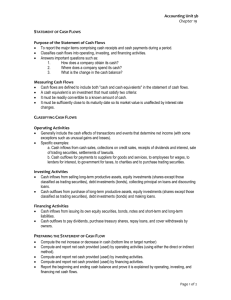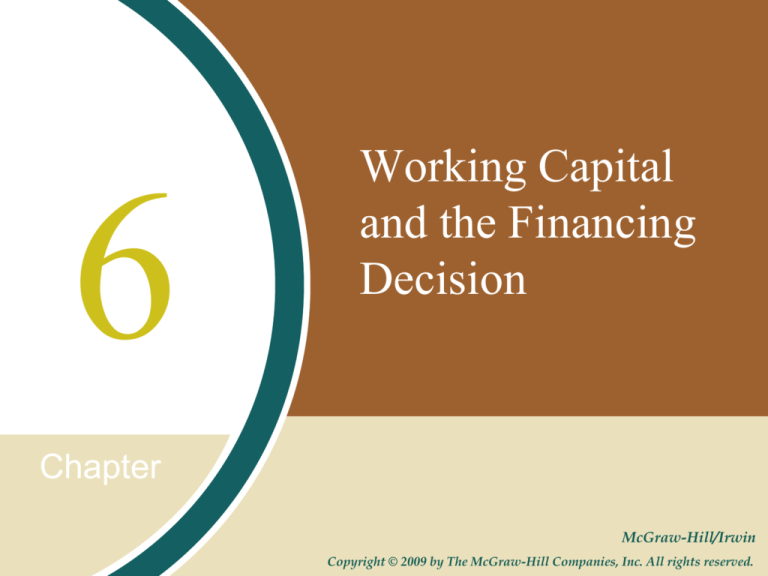
6
Working Capital
and the Financing
Decision
Chapter
McGraw-Hill/Irwin
Copyright © 2009 by The McGraw-Hill Companies, Inc. All rights reserved.
Chapter Outline
•
•
•
•
•
•
Working capital management
Current asset management
Asset financing
Long-term versus short-term financing
Risk and profitability vis-à-vis asset financing
Expected value analysis may sometimes be
employed
6-2
CASH BUDGET
• Cash Budget:
A schedule showing Cash Receipts, Cash
Disbursements, and Cash Balance for a firm over a
specified period of time.
• Target Cash Balance:
The minimum cash balance a firm desires to
maintain in order to conduct business.
• Receipts & Disbursements Method:
The net cash flow is determined by estimating the
Cash Receipts & Cash Disbursements expected to
be generated each period.
6-3
Cash Budget & Interest Costs
• The cash budget determines your future
ability to pay debts & expenses.
• Preliminary budget estimates may reveal
that your disbursements are lumped together
and that, with more careful planning, you can
spread your payments to creditors more
evenly throughout the entire year.
As a result, need less bank credit, and
interest costs will be lower.
6-4
CASH BUDGET
Beginning cash balance
Add:
Estimated cash sales
Estimated collections on A/R
$320,000
250,000
750,000
$1,320,000
Deduct:
Estimated payments on A/P
$ 800,000
Estimated cash expenses
150,000
Contractual payments on long-term debt 150,000
$1,100,000
Estimated ending cash balance
$ 220,000
6-5
Cash Budget by month ($K)
CASH FLOW
JAN. FEB. MAR. APR. MAY JUNE
CASH RECEIPTS
860 838 835 865 895 874
CASH DISBURSEMENTS 859 825 894 879 873 862
NET CASH FLOW
1 13 (59) (14)
22
12
Beginning CASH
Ending CASH
200 201 214 155
201 214 155 141
MINIMUM CASH BAL.
EXCESS (deficit)
175
26
141
163
163
175
175 175 175 175 175
39 (20) (34) (12)
0
6-6
Monthly Cash Budget
CASH FLOW
CASH INFLOWS
CASH SALES
AR COLLECTIONS
TOTAL INFLOWS
CASH OUTFLOWS
WAGES/SALARIES
AP DISBURSEMENTS
INTEREST
OTHER DISBURSEMENTS
TOATL OUTFLOWS
NET CASH FLOW
BEGINNING CASH BALANCE
ENDING CASH BALANCE
JAN. FEB. MAR. APR. MAY JUNE
230 200 204 220 240 230
630 638 631 645 655 644
860 838 835 865 895 874
200 200
550 510
5
5
104 110
859 825
1 13
200 201
201 214
210 212
559 552
5
5
120 110
894 879
(59) (14)
214 155
155
141
215 220
543 537
5
5
110 100
873 862
22 12
141 163
163 175
6-7
Collection on Accts. Receivable
Nov.
Dec
Jan
Feb
Mar
114,000
125,000
138,000
140,760
143,575
22,800
25,000
27,600
28,152
28,715
79,800
87,500
96,600
98,532
11,400
12,500
13,800
126,500
137,252
141,047
Collections on Credit Sales
Sales on Accounts
Collections During:
Month of Sale
First month after sale month
Second month after sale month
Total Collections
22,800
104,800
6-8
Cash Outflows (Payments)
Jan
Feb
Mar
Payments for purchases
69,000
70,380
71,788
Wages and salaries
29,630
29,658
29,686
5,000
5,000
5,000
31,670
31,781
31,893
Payments (Outflows):
Rent
Other expenses
Taxes
45,000
Capital equipment purchases
Total payments
135,300
181,819
138,367
6-9
Sales Forecasts, Cash Receipts, and
Payments, and Cash Budget
6-10
Working Capital
•
•
•
•
•
A firm’s investment in Current Assets:
Cash
Marketable Securities
Inventory
Accounts Receivable
6-11
Net Working Capital
• Net Working Capital
• = Current Assets – Current Liabilities
• = Amount of Current Assets
financed by Long-term Liabilities
6-12
Current Assets – Current Liabilities=
ASSETS
CLAIMS
Cash
Accounts Payable
M. Securities
Notes Payable
Acct. Receivable
Wages Payable
Inventory
Taxes Payable
Pre-paid Rent
Other Current Liabilities
Long-terms Debts
Preferred Stocks
Common Stocks
Retained Earnings
6-13
Working Capital Policy
• Target levels for each current asset account
• How current assets will be financed
6-14
Not Working Capital
• Current maturities of long-term debt
• Financing associated with a construction
program that will be funded with the
proceeds of a long-term security issue after
the project is completed
• Use of short-term debt to finance fixed
assets
6-15
The Cash Conversion Cycle
• The length of time from the payment for
purchases of raw materials,
• to manufacture a product,
• until the collection of accounts receivable
associated with the sale of the product.
6-16
Inventory Conversion Period
• Length of time required to convert Materials
into Finished Goods and then sell those
goods.
• The amount of time the product remains in
Inventory in various stages of completion.
• =Inventory/Daily Cost of Goods Sold
6-17
Working Capital Management
• The financing and management of the
current assets of a firm
– Crucial to achieving long-term objectives of the
firm or its failure
– Requires immediate action
6-18
Receivables Collection Period
• Average length of time required to convert
the firm’s Receivables into Cash.
• Days Sales Outstanding (DSO)
• =Receivables/Daily Credit Sales
6-19
Payables Deferral Period
• Average length of time between the
Purchase of Raw Materials and Labor and
the payment of cash for them.
• =Accounts Payable/Daily Credit Purchases
6-20
Cash Conversion Cycle
• Net the three periods
• Average length of time a dollar is tied up in
current assets.
• Cash Conversion Cycle
• =Inventory Conversion Period
• +Receivable Collection Period
• -Payables Deferral Period
6-21
Credit Management
• Credit Policy:
A set of decisions that include a firm’s credit
standards, credit terms, methods used to
collect credit accounts, and credit monitoring
procedures.
• Credit Standards:
Standards that indicate the minimum
financial strength a customer must have to
be granted credit.
6-22
Credit Management
• Terms of Credit:
• The payment conditions offered to credit
customers.
• Length of credit period and any cash
discounts offered.
• Credit Period:
• The length of time which credit is granted.
• After that time, the credit account is
considered delinquent.
6-23
Credit Management
• Cash Discount:
A reduction in the invoice price of goods
offered by the seller to encourage early
payment.
• Collection Policy:
• The procedures followed by a firm to collect
its Accounts Receivable
6-24
Credit Management
Receivables Monitoring
• The process of evaluating the credit policy
and payment patterns to determine
if a shift in the customers' payment pattern
occurs or
if the credit policy needs modifications.
6-25
Credit Management Analyzing Proposed
Changes in Credit Policy
•
•
•
•
•
Marginal Costs & Benefits
Change in Sales
Change in Variable Operating Costs
Change in Average Collection Period
Change in Carrying Cost of Receivables
6-26
Working Capital Management
• Financial manager’s most time-consuming
function.
• Success in managing current assets in the
short run is critical for the firm’s long-run.
• Nature of Asset Growth
• Seasonal & Permanent increases in Working
Capital must be financed.
6-27
The Nature of Asset Growth
• Effective current assets management
requires matching of the forecasted sales
and production schedules
• Differences in actual sales and forecasted
sales can result in:
– Unexpected buildup.
– Reduction in inventory, affecting receivables and
cash flow
• Firm’s current assets could be:
– Self-liquidating
– ‘Permanent’ current assets.
6-28
Controlling Assets – Matching Sales
and Production
• Fixed assets grow slowly with:
– Increase in productive capacity
– Replacement of old equipment
• Current assets fluctuate in the short run,
depending on:
– Level of production versus the level of sales
• When production is higher than sales the inventory
rises
• When sales are higher than production, inventory
declines and receivables increase
6-29
Controlling Assets – Matching Sales
and Production (cont’d)
• Cash budgeting process
– Level production method
• Smooth production schedules
• Use of manpower and equipment efficiently to lower
cost
– Match sales and production as closely as
possible in the short run
• Allows current assets to increase or decrease with
the level of sales
• Eliminates the large seasonal bulges or sharp
reductions in current assets
6-30
Temporary Assets under Level
Production – An Example
• Yawakuzi Motorcycle Company
– Sales fluctuations: High sales demand during
early spring and summer;
sales drop during October through March
– Decision: Apply level production method - 12month sales forecast is issued
– Result: Level production and seasonal sales
combine to produce fluctuating inventory
6-31
Yawakuzi Sales Forecast (in units)
6-32
Yawakuzi’s Production Schedule
and Inventory
6-33
Sales Forecasts, Cash Receipts, and
Payments, and Cash Budget
6-34
Sales Forecasts, Cash Receipts, and
Payments, and Cash Budget (cont’d)
• Table 6-3 is created to examine the buildup
in accounts receivable and cash
– Sales forecast: Based on assumptions taken
earlier (table 6-1)
– Cash receipts: 50% cash collected during the
month of sale and 50% pertains to the prior
month
– Cash budget: a comparison of cash receipt and
payment schedules to determine cash flow
6-35
Total Current Assets, First Year
($millions)
6-36
Yawakuzi’s Nature of Asset Growth
6-37
Cash Budget and Assets for II Year
With No Growth in Sales ($millions)
• Graphic presentation of the current asset cycle.
6-38
Patterns of Financing
• Selection of external sources to fund
financial assets is an important decision
• The appropriate financing pattern:
– Matching of asset buildup and
– length of financing pattern
6-39
Matching Long-Term and
Short-Term Needs
6-40
Alternative Plans
• It is important to consider other alternatives
– The challenge of constructing a financial plan is
to prioritize the current assets into temporary
and permanent
– The exact timing of asset liquidation, even in the
light of ascertaining dollar amounts is onerous
– It is also difficult to judge the amount of shortterm and long-term financing available
6-41
Long-Term Financing
• Firms can be assured of having adequate
capital at all times:
– Use long-term capital to cover part of the shortterm needs
– Long-term capital can be used to finance:
• Fixed assets
• Permanent current assets
• Part of the temporary current assets
6-42
Using Long-Term Financing for
Part of Short-Term Needs
6-43
Short- Term Financing
• Small businesses do not have total access
to long-term financing
– They rely on short-term bank and trade credit
– Advantage: interest rates are lower
– Short-term finances are used finance:
• Temporary current assets
• Part of the permanent working capital needs
6-44
Using Short-Term Financing for
Part of Long-Term Needs
6-45
Term Structure of Interest Rates
• A yield curve – that shows the relative level
of short-term and long-term interest rates
– U.S. government securities are popular as they
are free of default risks
– Corporate debt securities entail a higher interest
rate due to more financial risks
– Yield curves for both securities change daily to
reflect:
• Current competitive conditions
• Expected inflation
• Changes in economic conditions
6-46
Basic Theories - Yield Curve
• Liquidity premium theory
– Long-term rates should be higher than shortterm rates
• Market segmentation theory
– Treasury securities are divided into market
segments by the various financial institutions
investing in the market
• Expectations hypothesis
– Yields on long-term securities is a function of
short-term rates
6-47
Long- and Short-Term
Annual Interest Rates
• Relative volatility and the historical level of
short-term and long-term rates
6-48
Alternative Financing Plans
• A Decision Process: Comparing alternative
financing plans for working capital
6-49
Impact of Financing Plans
on Earnings
6-50
Varying Condition and its Impact
• Tight money periods
– Capital is scarce making short-term financing
difficult to find or may ensue very high rates
– Inadequate financing may mean loss of sales or
financial embarrassment
• Expected value
– Represents the sum of the expected outcomes
under both conditions
6-51
Expected Returns under
Different Economic Conditions
6-52
Expected Returns for High Risk
Firms
6-53
Toward an Optimal Policy
• A firm should:
– Attempt to relate asset liquidity to financing
patterns, and vice versa
– Decide how it wishes to combine asset liquidity
and financing needs
• Risk-oriented firm - short-term borrowings and low
degree of liquidity
• Conservative firm - long-term financing and high
degree of liquidity
6-54
Net working capital as a percentage of
sales—S&P Industrials
6-55
Asset Liquidity and Financing
Assets
6-56





